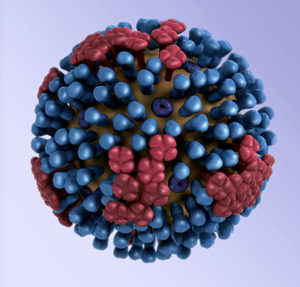By Deborah Roby
 The influenza virus prevents its own destruction and causes virulence by a newly discovered method. The non-structural protein 1 (NS1) of the influenza A virus allows disease proliferation by binding a protein that activates the host’s immune reaction. The lab of Yi Ren, in collaboration with researchers at various U.S. and Chinese institutions, discovered how NS1 prevents host detection of the virus and the specific mechanism by which it impairs the movement of host messenger RNA (mRNA) from the cell nucleus.
The influenza virus prevents its own destruction and causes virulence by a newly discovered method. The non-structural protein 1 (NS1) of the influenza A virus allows disease proliferation by binding a protein that activates the host’s immune reaction. The lab of Yi Ren, in collaboration with researchers at various U.S. and Chinese institutions, discovered how NS1 prevents host detection of the virus and the specific mechanism by which it impairs the movement of host messenger RNA (mRNA) from the cell nucleus.
Like all other flu strains, influenza A, a subtype of the H1N1 pandemic from 2009, copies itself in the nucleus of a host cell. Once infected with the virus, the host cell begins the process of making antiviral proteins to clear the infection from the cell, going from DNA to mRNA to protein. The mRNA, however, has to leave the nucleus before any antiviral proteins can be made. Thus, the better a virus is able to mask its presence in the cell by blocking mRNAs from exiting the nucleus, the more the virus can proliferate.
The important players in this process and this set of experiments are the NS1 protein; the nuclear pore complex (NPC), which provides a pathway for moving mRNA out of the nucleus; and the NXF1-NXT1 complex, which consists of two separate proteins (NXF1 and NXT1) that work together to physically bind the mRNA and shuttle it out of the nucleus through the NPC.
Using crystallography, the researchers discovered that the NXF1-NXT1 complex has to bind a phenylalanine amino acid on the NPC to export mRNA from the host cell nucleus. To counter this, NS1 displays two prominent phenylalanine residues to trick the NXF1-NXT1 complex into binding to it instead of binding to the NPC. To test this, the researchers switched the phenylalanine residues on the NS1 with another amino acid, alanine, and saw a decrease in binding to the NXF1-NXT1 complex. First author Ke Zhang and colleagues then overexpressed wildtype NXF1, the protein that contains the binding site for NS1, and effectively exhausted NS1’s binding capacity. This allowed the endogenous NXF1 protein within the NXF1-NXT1 complex to bind the host’s mRNA, shuttle it out through the NPC, and mount an antiviral response.
Multiple viruses inhibit the ability of host proteins to bind the NPC, blocking mRNA transport from the nucleus and contributing to virulence. Zhang and colleagues’ work is an excellent starting point for determining binding sites on other viral proteins, which may lead to effective targets for antiviral drugs.